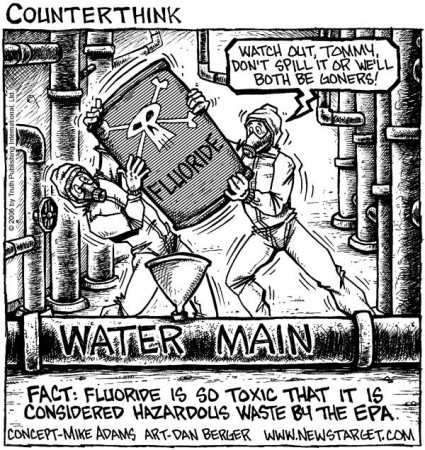Score One for the Anti-flouridation Cranks in Portland

Chalk one up for the forces of anti-science, quackery, and pseudoscience. The citizens of Portland, Oregon just handed them a huge victory the other day when they once again rejected water fluoridation in a referendum:
Fluoride supporters, it appeared, had everything going for them.
Five Portland city commissioners had voted to add fluoride to the city water supply. Health advocacy groups, and many of the city’s communities of color, lined up behind the cause. And proponents outraised opponents 3-to-1.
But none of that was enough. For the fourth time since 1956, Portlanders on Tuesday night rejected a plan to fluoridate city water, 60 percent to 40 percent.
Before I discuss why Portland could well have gotten it so very, very wrong, I’m going to say something that might come across as heresy to some proponents of science-based medicine, and that’s that this isn’t the end of the world. Unlike the case with the the anti-vaccine movement, the consquences of the antifluoridation movement are not illness, disability, and death. I realize that lately it’s been questioned whether the benefits of fluoridation are worth the costs and the battles. As for any public heatlh issue in which the population is being given a preventative treatment (such as vaccines or fluoridation), the issues surrounding the benefits and risks of water fluoridation are not always straightforward. I get it. I also get that public water supplies are a precious commodity. To justify putting something in them requires good evidence of safety and efficacy. However, what I don’t get are the overheated simplistic arguments that come out of the anti-fluoridation movement. As I’ve pointed out before, these days resistance to fluoride seems so…quaint. it’s so Cold War. Just ask General Ripper:
And you do know, don’t you, the true purpose of introducing foreign substances into our precious bodily fluids:
OK, OK, I know. I can’t help it. Whenever the topic of fluoridation comes up, I have a hard time not including those clips from one of my all-time favorite movies. Since it’s been two and a half years since I blogged about fluoride and the anti-fluoride movement; so I haven’t gotten to use them in a long time.
In any case, I understand that Portland didn’t have water fluoridation to begin with, and its citizens clearly don’t want it, given that they’ve rejected it four times over 57 years. That’s some long, sustained opposition there. And while it’s true that there is no scientific support for the vast majority of the arguments that were made against fluoridation (many of them were distortions, misrepresentations, and pure pseudoscience), the people of Portland won’t suffer any adverse consequences, because they never had water fluoridation to begin with. They just refused the benefits of fewer cavities and better dental health, which is their right. I think it was probably a bad decision, but it’s their right to make bad decisions and refuse a beneficial public health intervention. Apparently, Portlandians must like going to the dentist.
What bothers me about this decision is not so much that it was made but how it was made. I didn’t call this vote a victory for antiscience and quackery just because Portland voted against fluoridation. I called it a victory for antiscience and quackery because classic antiscience arguments appear to have won. It would be one thing if the decision had been made dispassionately based on the evidence and it was decided that the potential benefits weren’t worth it. Kyle Hill provides a very good description of the science of why from a public health perspective the case against fluoridation doesn’t hold water. The issue, of course, is that people don’t decide things strictly based on the science and the evidence. They might think that they do, but they don’t. Not even skeptics do. I realize that some of the cranks out there might not believe that I understand that, but I do. For instance, even though the pro-fluoridation forces had the stronger argument on a number of fronts, be it the safety of low level fluoridation or how since 1945 the fluoridation of drinking water has reduced tooth decay by 40-70% in children and tooth loss in adults by 40-60%, those arguments didn’t resonate. Neither did pointing out that fluoridation achieves these benefits with very little downside. What did resonate were campaigns about the “evils” of fluoridation, virtually all of which are canards, tropes, and just plain not true.
For instance, take a look at this antifluoridation poster:

Elswhere, on a Facebook page entitled Portlanders Against Fluoride, there is this picture:

Yes, that’s a Mike Adams cartoon you’re looking at there. Let’s just put it this way. If you’re using a ridiculous Mike Adams cartoon and don’t see the problem with doing so, you’re not science-based, and this group appears not to be science-based. Then there’s this TV ad.
Notice the fear mongering about fluoride, its characterization as not being of “pharmaceutical grade” and being the “byproduct of fertilizer manufacture.” This is a theme repeated in this commercial featuring Ed Begley, Jr.
I wondered how many times he’d repeat the word “chemical,” although I must give the producers of this commercial props for saying, “We don’t help kids by adding more chemicals to their water.” Hmmm. One wonders if Mr. Begley is as horrified by the addition of chlorine to his drinking water. Or does he realize that water (H2O, dihydrogen monoxide) is a chemical. Scary! In any case, the reason I give sarcastic “props” is because it’s a very clever line that plays into people’s fears of “chemicals” and environmental contamination, the purest demagoguery. The ad finishes up with bold letters saying “Please vote no to fluoridation chemicals” and a link to cleanwaterportland.org. Chemicals? Fluoridation involves adding only one chemical. In any case, Clean Water Portland (CWP) is chock full of distortions used by antifluoridation cranks. There again is the old familiar “Fluoridation chemicals are unpurified industrial byproducts from fertilizer manufacturing, and are not the same as the fluoride in toothpaste.” In fact, reading the website, I’m hard pressed to find CWP referring to anything but “fluoridation chemicals” rather that fluoride or fluoridation. It’s repeated so often that it’s jarring to me and clearly meant to play on people’s fear of chemicals rather than on reason or evidence. Personally, I think that these slogans would be far more appropriate for the antifluoridation movement.
So what about this issue of fluoride being derived from “waste products” of fertilizer manufacture? The whole thing irritated me enough to look it up, and it didn’t take me long to find my way to the CDC webpage on fluoridation:
Most fluoride additives used in the United States are produced from phosphorite rock. Phosphorite is used primarily in the manufacture of phosphate fertilizer. Phosphorite contains calcium phosphate mixed with limestone (calcium carbonates) minerals and apatite—a mineral with high phosphate and fluoride content. It is refluxed (heated) with sulfuric acid to produce a phosphoric acid-gypsum (calcium sulfate-CaSO4) slurry.
The heating process releases hydrogen fluoride (HF) and silicon tetrafluoride (SiF4) gases which are captured by vacuum evaporators. These gases are then condensed to a water-based solution of 23% FSA with the remainder as water.
Approximately 95% of FSA used for water fluoridation comes from this process. The remaining 5% of FSA is generated during the manufacture of hydrogen fluoride or from the use of hydrogen fluoride in the manufacturing of solar panels and electronics.
Since the early 1950s, FSA has been the chief additive used for water fluoridation in the United States. The favorable cost and high purity of FSA make it a popular source. Sodium fluorosilicate and sodium fluoride are dry additives that come largely from FSA.
So there are good reasons to use FSA as a source of fluoride, and the fluoride additives, as is pointed out elsewhere on the page, are not different from naturally occurring fluoride. It’s the same fluoride ion. Again, the antifluoride forces were playing on the public’s fear of chemicals and misunderstanding of chemistry to make fluoridation seem a lot more scary than it is. (Actually, it’s not scary at all.) As always, the dose makes the poison, and the levels used in municipal water supplies has a long history of safety. Indeed, as Kyle Hill points out, it’s a matter of regulating the concentration of fluoride ion in the water supply; in some “unfluoridated” water sources, the concentration of fluoride ion can be considerably higher than what is added to other water sources in the form of FSA.
Most of the rest of the arguments on the website are no better. For instance, they cite a truly bad “Harvard study” that is represented as showing that fluoridated water “lowers IQ,” but in reality shows noted, at least not with respect to fluoridation of water. Indeed, associations between fluoride concentrations and lower IQ were only found at the highest levels of fluoridation, same as I noted for an earlier study purporting to have found a negative correlation between fluoride concentration in drinking water and IQ. Moreover, the claims that “more recent” science calls the benefits of fluoridation into question are just not true. Indeed, most of the canards used to attack fluoridation are either distortions or not true.
Such were the sorts of arguments flooding the airwaves and the phone lines in the weeks leading up to the election in Portland, and they had their effect. Given the history of Portland’s long skepticism of the benefits of fluoridation, it was an uphill battle to convince its citizens to approve a measure like this. Indeed, fact that it even got on the ballot in the first place shows how intense the opposition was in the first place. Such a citizenry was thus arguably more susceptible than most to these sorts of dubious, one-sided, and distorted arguments. Of course, that’s politics, as much as you or I might wish it were not so, and politics doesn’t run by reason, logic, and science, at least not most of the time. What that means is that emotion-laden, scary appeals to the evils of “fluoridation chemicals” and “fertilizer byproducts” and referring to fluoride as a “pesticide” or “rat poison.”
It is possible that times have changed and, as some have argued, the routine fluoridation of drinking water no longer makes as much sense as it once did. Back in the 1940s and 1950s, there were few sources of dietary fluoride, and adding it to the drinking water made a lot more sense, just as adding iodine to salt made sense for similar reasons. However, our water is a precious resource that everyone needs and uses. Adding something to it is not something to be done lightly, because it affects everyone. The advantage of that is that affecting everyone equally is very egalitarian. Indeed, that was one of the strongest arguments for fluoridation in Portland: Equity, in which the poorest children, the ones who tend not to have access to good dental care, get the same benefits of fluoridation as the affluent. The down side is, of course, that everyone is affected equally. If there are risks, such as dental fluorosis, the entire population is exposed to them. Given the greater access to fluoride-containing tooth care products and the use of fluoridated water to make many drinks and food products, fluoride is more available today.
An added curiosity to this whole story is the politics. As everyone knows, Portland is about as crunchy lefty as it gets in the United States, and, indeed, there were lots of stories about how the fluoridation issue had split the left in Portland. However, as the clips from Dr. Strangelove above show, traditionally back in the 1950s and 1960s, opposition to water fluoridation was traditionally the bailiwick of the far right fringe, the John Birch Society, and those who believed that fluoridation was a Communist plot to mass medicate the people of the U and thus contaminate their “purity of essence.” To some extent, it still is. The “health freedom” movement and various conspiracy websites such as Alex Jones’ website flog the fluoride beast on a regular basis. But in Portland, it was primarily the crunchy left that used similar arguments, namely to protect the purity of the water and, of course, their own “purity of essence” from “contamination.” They say that the farther you go out on the left or the right, the more they start to resemble each other. In this case, it was somewhat true.
In any case, public policy is best driven by science and evidence, where the best science informs the political process. In the case of Portland, from where I stand, the question of whether water fluoridation was good public policy was not decided that way in Portland.


